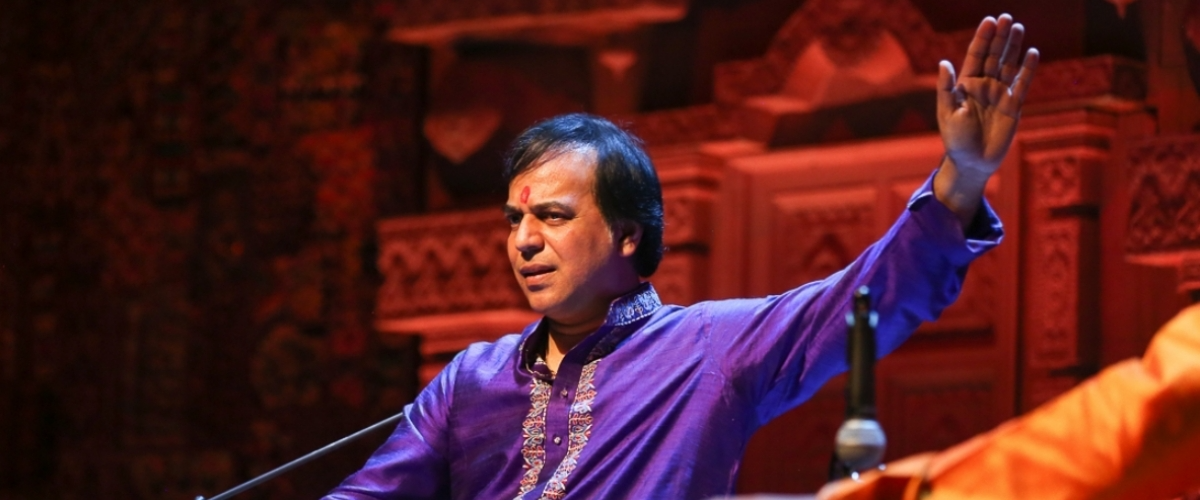

The Benares tabla maestro discusses jazz, turning down the Sugababes, and the links between rhythm and food.
—Part of Living Traditions: 21 articles for 21st-century Indian classical music
Precise, powerful, and intricately funky, Pandit Sanju ‘Vishnu’ Sahai embodies the Benares rhythm gharana. As the sixth generation of his family’s illustrious tabla lineage he was born into music, virtually preordained to master the instrument. His talent was quickly recognised - at age 9 he was playing major festivals, and he completed his music degree at 13 with a Masters following at 18. He has since spent decades immersed into Indian rhythm.
He is mindful of diluting classical tabla, but this has not prevented him taking it into a breathtaking array of new contexts. Alongside accompanying top Hindustani musicians he has collaborated with artists spanning jazz and flamenco to opera and Gregorian chant. He has played in schools and prisons as well as for the Queen, and teaches at SOAS in London.
Sahai is a superb off-stage ambassador for the music he reveres, driving me around and allowing our lunchtime interview slot to turn into a four hour curry sampling session (“real Indian food, made with traditional ingredients”). His conversation mirrors his playing - patient, eloquent, and deeply knowledgeable.
But a reserved manner never masks his restless and obsessive musical passion. Rhythm to him is a way of life, allowing him to keep the spirits of his ancestors alive and communicate with anyone, anywhere. This is a condensed and tidied account of our discussion.
You've lived in London for years now. People respond differently to unfamiliar music, and improvisation is always influenced by the reactions of the room. Do you change your style much when playing to Westerners?
I don’t intend to play any differently - I give my best every time, just as my gurus did. But the energy is different when performing in India, and the expectations are higher. It’s the home of the music - you feel the history, and the fact it was created there. The audiences can be very knowledgeable.
There’s a temple in Benares where they hold six consecutive nights of free concerts each year. The crowd will walk out if they don’t like what they hear, even when top-grade artists are playing. They prefer to go and drink chai if the music isn’t right! So playing in India pushes me to perform better.
In the West, listeners can be less critical, and even fool themselves into thinking they truly like it when it hasn’t resonated as it should do. Some people want to ‘tick off’ top artists, and post on Facebook to show they’ve attended. But you should never give less because an audience is more easily impressed. You can cry in response to music you don’t understand, and an artist should never weaken the ideas of their ancestors.
I guess the East-West divide isn’t always such a good guide to how people will react anyway. The textures of tabla can really captivate those who haven’t heard them before (even when played by a student such as myself), and modern learners are spread around the world.
Yes - I remember a concert in Amsterdam with nearly a thousand people in the crowd. I only saw one person clapping along to the tala [rhythm cycle], and couldn’t help feeling that I was playing straight to him. Each time you see something like this then you’re reminded how much our music can mean to people anywhere, and this motivates you to represent it as well as you can.
Indian classical music is special in that it allows for this direct two-way communication with the audience. I love Western classical music too, but remember going to a concert aged 11 and being told not to clap between movements. I thought this was so strange - audiences should be able to let the artists know when they’re feeling something!
• You always keep a backbone of ‘pure’ classical performance, but collaborate with a global range of musicians too. How do you go about choosing your next projects?
Nowadays I turn down more concerts than I accept. This wasn’t always the case - in my youth then I readily played with many different musicians. I’ve never sought to limit myself, then or now - it’s about what you feel your limits are, and planning how to overcome them with an open mind.
Once I was playing with a flamenco dance group. You feel a particular responsibility for your tradition at times like this, as I could see how much respect the dancers had for Indian classical. I may be playing, but the music is not really mine - it draws on the dedication of generations, with ideas that span thousands of years.
I guess flamenco and Hindustani share some stylistic influences, notably an Islamic-coloured use of Bhairavi-type scales. Do links like this help you play 'classically in fusion settings? Or is it a challenge to keep the different styles you play distinct from each other?
I’m a classical player, and will instinctively look in this direction whatever situation I’m in - you must have respect for your ancestors. But when working in a fusion setting you can’t just ‘speak Hindi’, as you will be speaking to yourself. You have to find common ground, and a language that can be understood by all.
Where do I find this from? I don’t really need to draw on ideas from outside my tradition. But this doesn’t mean I will play 100% classical style either - I aim to find a different dialect from the ideas I know, created to fit each situation. Your hearts have to beat together before you can play really well.
I always select my collaborations on the basis of the music, and over the years I’ve played allsorts. I’ve performed on the street, as well as in prisons, detention facilities, centres for the disabled, and so on.
Once I was preparing for a concert with sitar, Indian vocals, and eight opera singers. The khayal [North Indian vocal] performer didn’t initially see a way to fit with the other sounds. She was used to the responsiveness of Hindustani music, and found it hard to adjust to classical musicians who don’t always look up from the score.
So we discussed how to break down the musical languages the opera singers were using, and then look deeper into our own traditions. It wasn't a situation in which to borrow their ideas directly, or get them to adjust very much. In the end, she really made it work!
So you feel you can play in non-traditional settings without compromising too much?
Yes, definitely. I once went on a UK tour with [sitarist] Niladri Kumar, performing 17 dates across venues that included bars and nightclubs. We played real Hindustani music, and found we could captivate the audiences for about half an hour before they started to get distracted. But we had a great time without feeling like I was compromising with our traditions.
Some decisions are easier than others. Once I was asked to perform with the Sugababes. The manager wanted me to sit on stage and mime rather than play. I told them, “you’ve got the wrong guy - I practice this music 12 hours a day. I love it and this way does not allow me to respect it”.
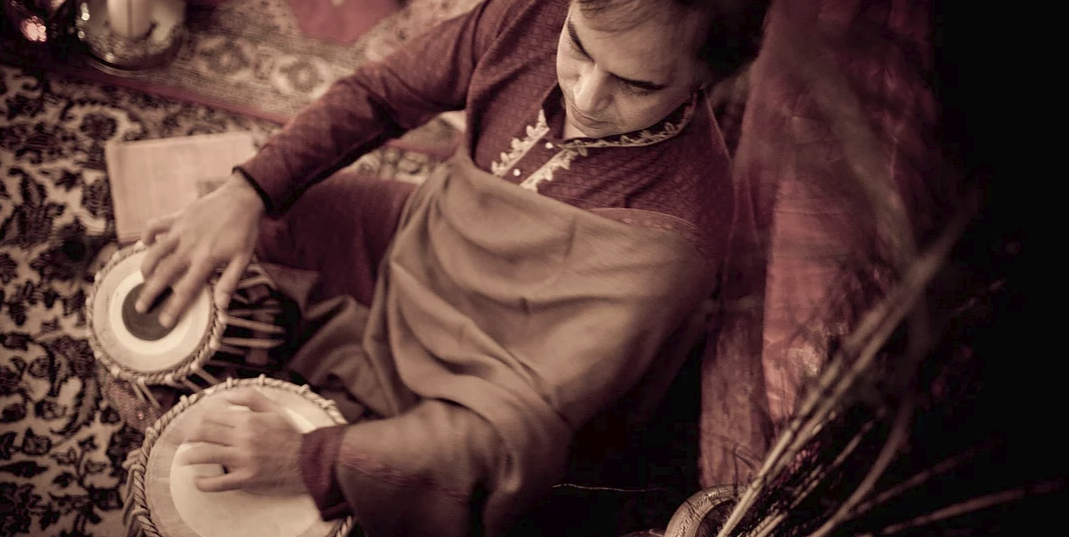
Not a member of the Sugababes. Photo: S&H Grewal
The Benares gharana is of paramount importance to recent tabla history. It has maintained its core foundations without ever remaining static either - how do you balance preserving traditional forms with continuing to innovate?
Each generation builds on the ideas of those who came before them. After all, Benares is the youngest of the great tabla gharanas. Our music must always be contemporary - it won’t survive as it should if I only play old Benares styles. I must find a bridge, and always be authentic as I search. I never want to be labelled as something I’m not.
Others can go ahead and focus on fusion, but I feel that I have a greater responsibility. The name of Sahai is important as it represents my ancestors. Musicians still look to us and to Benares, and I can’t help but feel that if I compromise too much then others will too.
Like our food, our music is diluted too much in the UK. If you change the taste then you are responsible for the damage that it can cause. Music and food can both be superficially Indian, and there is too much emphasis on ‘filling tables’ rather than providing the highest quality you can. But there is nothing like the real thing.
Artists often speak of ragas as if they were friends. Dr. Ashwini-Bhide Deshpande was talking to me about getting to know their characters, maintaining the relationships, and even considering how they may fall out or drift apart. Do you feel anything similar about talas?
There are all sorts of different ways to conceptualise a tala, but seeing them like people isn’t usually a very literal process for me. Rhythms are very flexible, and can carry many different moods and characters.
Perhaps we’re less inclined to see them as people because rhythms don’t represent the human voice as clearly as melodies. But when we do it can be very specific - Ashwini-ji was telling me how she visualises three 14-beat talas with three very different scenes.
For her, jhoomra is a woman walking in a sensual way, showing her beauty. Deepchandi walks in a more reserved, dignified manner, as it lacks the flamboyant TiReKiTe bols. And dhamar is a male warrior walking slowly to the battlefield.
That’s very interesting - I can also see dhamar as a warrior moving slowly forward, but for me he proceeds like this as he is riding an elephant! Many talas are very flexible, but dhamar should be slow like this. In the West it is often played too fast - if this happened in India then the rasikas [connoisseurs] might walk out...
The tabla is famously capable of breathtaking speed. Some of the older artists I’ve spoken to say that modern playing can be too flamboyant, focusing too much on relas ['rushing' compositions], laggis [fast-flowing pieces in simple rhythm], and other dense cascades of strokes rather than lyrical accompaniment. Do you feel this?
We live in a speed age nowadays, but this is only one requirement of playing the tabla. To some it may seem like the most impressive, but it definitely isn’t the most challenging to master.
Besides, excessive speed can lead you to miss the full extent of what is going on. Anyone can be impressed by the pace of a fast car as it goes past, but a real connoisseur should also appreciate the colour, the design, the driving style, and so on.
We should not rush any aspect of this music. I’ll tune for as long as I feel I need to on stage. Cooking is about exact ratios, and so is music. It’s better to have perfect ratios of five ingredients than 20 in total.
[I pause to appreciate the excellent curry Sanju has selected for me]
Our music is a language, and it is not supposed to be distractingly fast. Speed and volume have too much importance in modern times, and this can kill the music. I like the tabla how it is - I don’t want to destroy the most melodic percussion instrument in the world. In this respect I’m a traditionalist, but upholding it can be hard work.
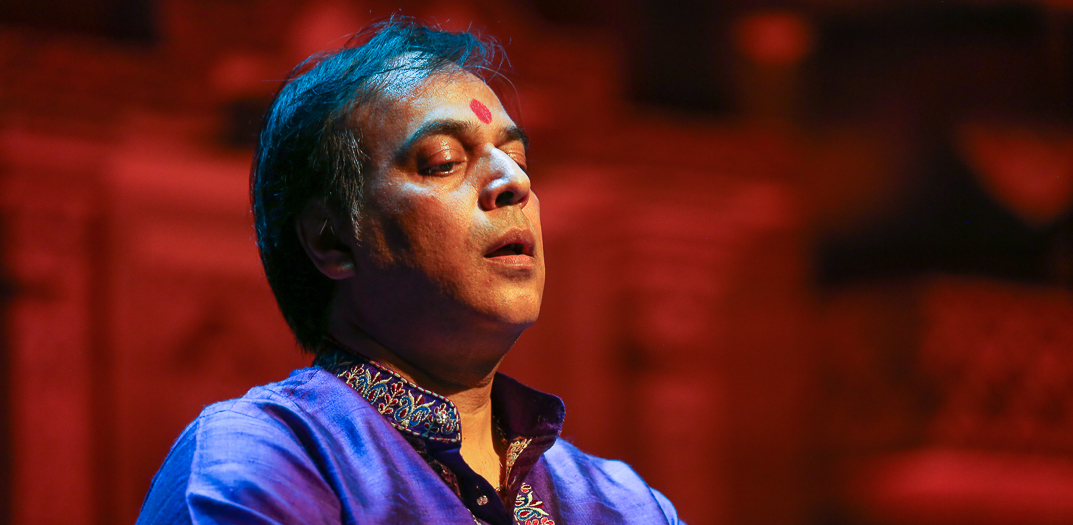
“Cooking is about exact ratios, and so is music". Photo: Rehmat Rayatt
Some traditional artists have created new ragas - Ustad Ali Akbar Khan’s Chandranandan, Pandit Ravi Shankar’s Jogeshwari, and Pandit Shivkumar Sharma’s Antardhwani. Would you ever introduce genuinely new talas to classical music?
Creating new compositions is one thing, but I don’t feel the need to create brand new talas. At the moment I feel like I can only capture about five percent of the old maestros’ capabilities, so there is still so much space for me to explore. I can play 20 hours a day in this lifetime, but won’t be half as good as my dad was [Pandit Sharda Sahai].
In any case, even if I made a new tala then it would not really be made of new ingredients. There is such depth and detail in the traditional forms. I can admire new creations, but don’t need to do this myself. It is better to master what you have.
You’ve taught for a long time, including taking students at SOAS for over 20 years. The contexts for tabla tuition are changing - I had no guru where I lived before, so learned by shuffling up my iTunes collection and playing along to anything my Na stroke is consonant with. How else are teaching methods opening up? How do you approach it?
My father used to say: “Slow down son, you run around the world too much - find more time to teach”. After his passing in 2011, I really took his advice. I could go back to Benares for this, but something tells me I should stay here in the West for now. There is more work to be done here.
I’ve taken many different approaches to teaching over the years. You need to keep your approach fresh each time - this way the music stays relevant. Each year at SOAS I aim to start from scratch, and challenge my own habits as well as those of students. At the weekend I run a local Indian classical music club, including different age groups.
Riyaz [immersive practice] should not be forced - being made to close your eyes doesn’t mean you are meditating. If you only want to practice for 20 minutes then practice for that long, and if you don’t feel like playing that day then don’t. You can force yourself to practice for five hours, but if you didn’t want to do it then how many minutes were you really there for? You must be fully present.
I taught at the Menuhin School, and banned written music from my sessions. I have nothing against reading music, but it is not how to approach what we’re trying to do. There’s no point reading the map as you’re driving. Each performance is like a sports match - you can never repeat all the details, and should never want to.
I want to teach in such a way that my students will get in trouble because they won’t stop playing. The core is always to get the range of strokes down, and to teach them how to play rather than dictating exactly what to play. A student who truly cares can find their own path from there. As children we’re taught to walk, but not to run. We work that out for ourselves.
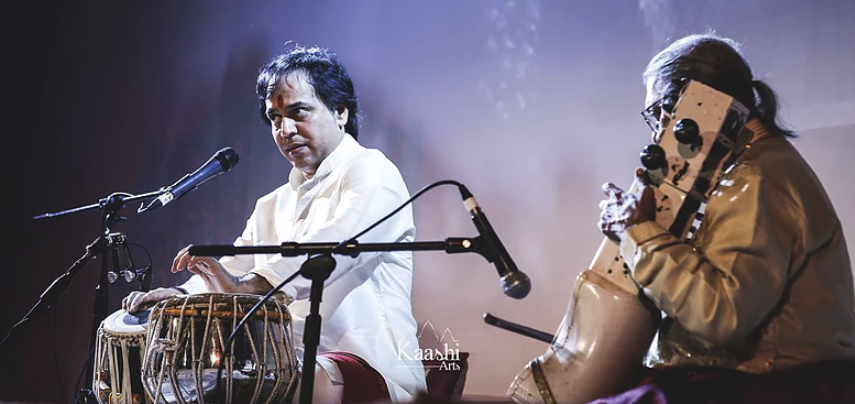
“Like a sports match - you can never repeat all the details”. Photo: Kaashi Arts
How about your own learning? What was it like studying in such a traditional setting?
I grew up in the music district of Benares, in a family of tabla players. Pandits Rajan and Sajan Mishra lived close by, as did many other artists - including your own guru [sitarist Pandit Shivnath Mishra]. Growing up hearing them was truly unique. Sometimes they would complain if they could not hear your riyaz!
To really learn you have to practice - you have to go crazy really. I played 12 hours a day, renting a room away from the city and focusing on my riyaz. I didn’t have to do this, but wanted to escape distraction. 200 years ago my ancestor Pandit Ram Sahai retreated to the Uttar Pradesh jungle for two years with his tabla, surrounding himself with nature and wildlife. This is part of how the Benares style was formed.
Wow - maybe this is the Hindustani equivalent of jazz saxophonist Rahsaan Roland Kirk going to New York Zoo and playing to the animals! And the introverted dedication you describe reminds me of jazz in other ways too - Sonny Rollins took a two-year sabbatical after becoming famous, turning down all concerts and sitting alone on New York’s Williamsburg Bridge, playing to the East River down below.
I can see why he did - dedicated musicians always have something like this within them. Someday I would like to take a two-year break from performing to focus on a deeper development of my own style. But these things are not so practical - of course I care greatly for my family here. The distractions of today’s world make it hard to focus like the old masters did. But learners have to adapt.
Do you think that a player who learned outside of the traditional gurukul system will ever reach the highest levels of Hindustani classical?
Everything is possible, but some ingredients will always be required. You must work very hard, with the right guru, and have clarity on what you want to achieve. You should be aware of what else is going on and learn from other players, and perhaps have luck with concert promotions too.
I believe you must regularly see your guru in person to become a top artist. I learned constantly from my father even when we weren’t playing. It’s your whole life. You must educate yourself not to imbibe nonsense, whether that is from superficially spiritual swamis or the distractions of Facebook. But it is hard - I have no agent, and each concert can require twenty emails now.
The only way is to look deep within yourself, and also to analyse what other people had to do to master the music. Success comes from within. I’ve played for the Queen four times, but it is just another performance. Why should it change you?
Most Hindustani maestros - including yourself - showed great aptitude early in life. It seems difficult to forge a career path without early success, but I always wonder what talent is lost this way. John Coltrane didn’t really catch anyone’s ear until well into in his twenties...
Coltrane never left his perseverance, so he could overcome these setbacks. He had the right attitude, and followed his heart. In these respects he was a musician before he ever played. Having potential is important, but it can come in many forms. Nobody can stop you if you are truly dedicated, and set on your goals.
My situation was very different to Coltrane’s - it was decided before my birth that I would be a tabla player. In this respect I had little choice, but I wouldn’t have chosen differently. However the pressure was there - musicians in Benares would tap me on the back aged four and say “you’ve got to do it”.
Carnatic vocalist Aruna Sairam told me in an interview that women musicians “are constantly told you’re not good enough…and society expects you to nourish others first”. But she also said that young female musicians have more opportunities than they used to. And [sitarist] Purbayan Chatterjee said he comes across more superb female tabla players nowadays. Do you feel things are becoming more equal?
Excellent female players are definitely more visible nowadays. But they were there 20 years ago - it was just much harder for them to get noticed. My older sister was a talented tabla player, but she gave that life up when she married.
Thankfully attitudes are changing, and this doesn’t happen as much nowadays. There are so many superb female musicians. If women can be wrestlers then why can’t they be tabla players?
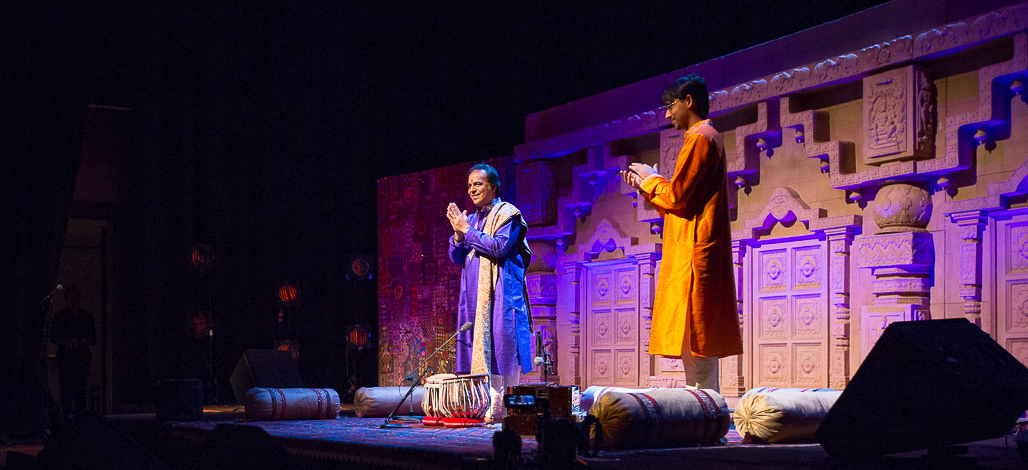
Mutual appreciation at the Barbican. Photo: Rehmat Rayatt
How do you approach criticism? From yourself, your gurus, or anyone else...
As a child I had to take out my tabla for every guest who visited the family home. I would be praised and criticised by top musicians from this age. This could be hurtful, but in the end you always want to see which direction to take next. They can help you do this.
I always feel that being diplomatic is very Western. There is no point kidding people - they do not want you to mislead them, and deserve to be able to learn as well as they can. I teach for the love of it, and will instruct dedicated students for as long as I live.
A couple of the guests in this restaurant have greeted you, and thanked you for your teaching. Does your position as a tabla artist infuse your everyday life in the UK away from the stage?
It can do. Once someone came to change the broadband and noticed my tabla. He asked if I played, and then remembered that he had seen me years ago (“yeah I remember - you were making train sounds!”). And I recently saw two women who watched me play 20 years ago, and were kind enough to tell me how much the music still resonated with them.
You seem to be constantly busy with different projects. What musical endeavours have you got lined up for the rest of 2018-19?
Anoushka Shankar and I, along with other musicians, are touring a live soundtrack to Shiraz, a 1928 silent film. I’ll also be performing in European concerts of Philip Glass’ Passages and collaborating with Dominique Vellard, a specialist in Gregorian chant who has previously worked with Aruna Sairam [listen here].
I’m also off to India (for the seventh time this year) to play some of the major festivals there and tour with some living legends. I will also be putting on some residencies in a few different places while I’m there. Alongside this I’ll be running various educational projects here in the UK, as well as preparing for teaching students at SOAS. And next week I’m going to France to visit John McLaughlin and Zakir Hussain.
Tabla players around the world are utilising loop pedals, production software, and so on. Using technology isn’t a new thing - Zakir Hussain has talked about how modern bayan [bass drum] playing has been influenced by microphones, amplifying the nuances. But Hindustani classical is fundamentally about the acoustic sound. How do you feel about new technology?
First and foremost, our music is acoustic, and I don’t find I play differently with a microphone. The music has to be within you, and no technology will compensate for deficiencies here. Besides, there are many subtle sounds which will not come through on a microphone.
Musicians sometimes speak of ‘unanswered questions’ with regard to their own approach, which continue to drive them. What questions like this do you have?
Unanswerable questions are very important - I start from the top down, and find they arise from there. I consider the fundamental questions about myself, which I would never wish to have fully answered. What is it I really want from playing the tabla? How can I best uphold the traditions of my ancestors? I always ask myself what they would think. They have given me so much.
• George Howlett is a London-based musician and writer, specialising in jazz, rhythm, Indian classical, and global improvised music.
Darbar believes in the power of Indian classical music to stir, thrill, and inspire. Explore our YouTube channel, or subscribe to the Darbar Concert Hall to watch extended festival performances, talk and documentaries in pristine HD and UHD quality.
The sitar genius discusses musical purity, hyper-discipline, and following the green light when improvising. By...
Read More 
The veena, also known as the been in North Indian languages, is a large plucked lute. It is undoubtedly one of...
Read More 
The sarod is a plucked string instrument, now as popular and predominant in North Indian classical music as the sitar.
Read More 
The beginner's guide to Indian classical music. Whether you’re completely new to raga music or just need a refresher, we’ve put together this brief overview of all things raga music to help you feel at ease when visiting one of our concerts or watch our videos on our YouTube or our Darbar Concert Hall.
Keep up to date with the latest news, events, music and musings across our social channels
For hundreds more clips and shorts, vist our YT page here 